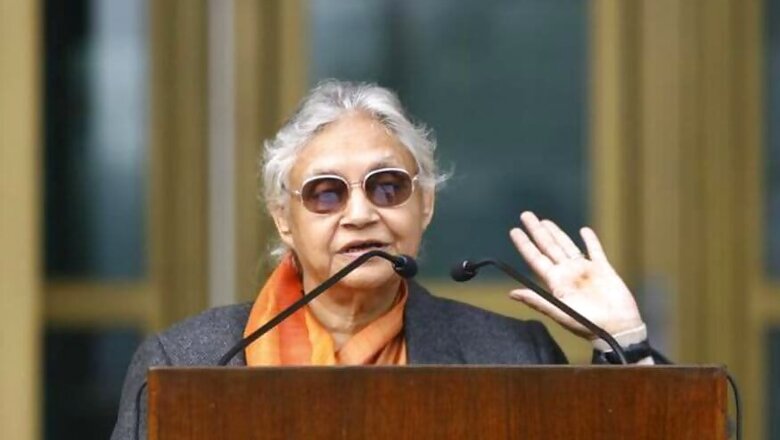
views
As one approaches the ‘finally made operational’ Signature Bridge from the trans-Yamuna area on a bumpy, ill-maintained road, on the left side is the premises of Delhi Government-run Industrial Training Institute (ITI). It was here two decades ago that Congress leader Sheila Dikshit had made her presence felt in politics of Delhi.
In the winter of 1998, when the polls were held for 12th Lok Sabha, Dikshit - a political leader from Uttar Pradesh, unknown to the rough and tumble and more importantly machinations of the politics of the national capital - was pitted against BJP strongman Lal Bihari Tiwari from the East Delhi seat.
Tiwari, a Minister in the Madanlal Khurana and Sahib Singh Verma governments, was the BJP’s Poorvanchal face as the voters from the region had started to have their presence felt in the national Capital. He had won the by-election from the seat about a year ago with a margin of 1.5 lakh votes. Dikshit, in addition to Tiwari, also had to counter the ‘influence’ of sidelined Delhi strongman HKL Bhagat.
The ITI campus was the counting centre for East Delhi seat during the Lok Sabha polls in 1998. In those days, it took nearly 24 hours to count the ballot of East Delhi Lok Sabha seat, then spread across 20 assembly segments.
Dikshit, who had been dubbed by the newspapers as “Sheila Who, Dikshit or Kaul”, had managed to give the BJP a run for their money. For records, Kaul was also from Uttar Pradesh and a minister in PV Narasimha Rao government.
In that 1998 election, Dikshit polled over five lakh votes, taking the vote percentage of the Congress up by nearly 20 percent from the bypolls held in 1997. Her close defeat was attributed also to presence of a Muslim candidate from the BSP, who had polled about 35,000 votes.
Despite the defeat, Sheila Dikshit resurrected the Delhi Congress, becoming its president six months later and leading the party to a massive victory in the assembly polls in December 1998.
Two decades later, Dikshit, brought back once again as the president of Delhi
Congress, has a similar task at her hands.
She has to resurrect the fortunes of her party in the capital.
The Congress suffered the ignominy of winning ‘zero seats’ in the last assembly polls held in 2015 and the road for recovery is going to be arduous given the presence of Aam Aadmi Party (AAP) under the leadership of present Delhi chief minister Arvind Kejriwal and a BJP riding on Prime Minister Narendra Modi’s personal charisma.
However, ever since she returned to the Rajiv Bhawan headquarters of the Delhi Congress, she has been consistent on the line that her party had sufficient energy to run the poll machinery, and that she did not wish to join issues on the demands of statehood.
Given her record of governance, she saw no logic in supporting the AAP on the matter, which the ruling party is using largely as a ruse to counter opposition criticism.
Kejriwal had fought the 2015 polls on the “freedom” agenda, that is freedom from paying power, water and Wi-Fi bills. After winning the polls, in the first meeting he had with the Prime Minister, he raised the issue of full-statehood. It was done as an act of political precaution.
Dikshit doesn’t share the sentiments on the demand for full statehood.
An alliance with the AAP would have been founded on arithmetic of vote share than chemistry between the two parties. Kejriwal’s MLAs, especially those belonging to the Sikh community, had threatened to revolt in case of an alliance with the Congress.
The decision of the Congress to go it alone would prove to be beneficiary in the long run, if not immediately, especially given the unlikely coming together of the cadres of the two parties and the assembly polls less than a year away.
In selecting its candidates, Congress has sent its old warhorse JP Agrawal to his ‘home
constituency’ of Chandni Chowk, a seat which was taken away from him in 2004 to accommodate Kapil Sibal.
Following delimitation in 2009, Chandni Chowk has more Bania population than it had before. Both AAP and BJP have fielded Bania candidates but Agrawal has the ‘face value’ of being a ‘Purani Dilliwala’, which Dr Harshvardhan of the BJP and Pankaj Gupta of the AAP are not.
The class battle, however, would be on North East Delhi seat where the BJP’s local unit head Manoj Tiwari is pitted against Delhi Congress head Sheila Dikshit.
Both Tiwari and AAP candidate Dilip Pandey, who incidentally heads AAP’s Delhi unit, are going to compete for the large Purvanchal votes, which could benefit Dikshit, whose fortunes are largely dependent on which side the Muslims vote.
In West Delhi, the party has moved shrewdly to pitchfork former MP Mahabal Mishra. He is looking to take advantage of the division in the dominant Jat Votes between sitting MP Parvesh Verma of the BJP and the AAP candidate Balbir Singh Jakhar, who is also the president of the Bar association of Dwarka court.
It would be interesting to watch which side the Sikh vote in the constituency would go, which had last time voted en bloc for the AAP. Since then AAP’s most prominent Sikh face HS Phoolka has left the party.
In 2009, the Sikhs in Delhi, on the appeal of Dr Manmohan Singh, had voted for the Congress. This time around, Arvinder Singh Lovely from East Delhi is the only Sikh candidate fielded by the three.
On the New Delhi seat, in Ajay Maken the party has put forward the best possible candidate. Maken commands following among his community (Punjabi) voters and also government employees for having worked for the announcement of the 7th Pay Commission
In 2009, AAP had fielded prominent journalist Ashish Khetan from New Delhi, who had polled close to 3 lakh votes. Khetan has since left the party and their nominee this time is one Brijesh Goel.
In East Delhi, former Delhi Congress president Arvinder Singh Lovely, who had briefly travelled to the BJP, has been fielded. Lovely has won Gandhi Nagar assembly seat from the area in 1998, 2003, 2008 and 2013.
What has surprised many is choice of Delhi Congress working president Rajesh Lilothia from the reserved North-West seat ahead of former Minister Rajkumar Chouhan. Perhaps, the fact that Lilothia belongs to a numerically dominant Jatav community weighed in his favour.
The imprisonment of former MP Sajjan Kumar in anti-Sikh riot case initially threw a jammer in Congress’s plan for going full-steam ahead in South Delhi constituency.
In his absence, party found it difficult to find a candidate but given Jat patriarch Bhupinder Hooda’s intervention, it has now fielded a ‘famous’ Jat face in boxer Vijender Singh.
With almost all tickets by the three main parties distributed, a keen contest, that too a triangular one, awaits in the national Capital.




















Comments
0 comment